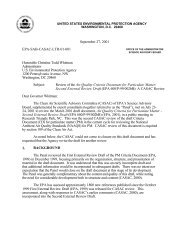(CASAC) Peer Review of EPA's Integrated Science Assessment
(CASAC) Peer Review of EPA's Integrated Science Assessment
(CASAC) Peer Review of EPA's Integrated Science Assessment
You also want an ePaper? Increase the reach of your titles
YUMPU automatically turns print PDFs into web optimized ePapers that Google loves.
Dr. Christian SeigneurComments on SOx ISA – 2 nd DraftCharge Question 2. Have these revisions to Chapter 2 improved its assessment <strong>of</strong> thecurrently available scientific knowledge on atmospheric sciences and exposure and itsrelevance to the evaluation <strong>of</strong> human health effects presented in later chapters?The second version <strong>of</strong> the ISA for the health criteria <strong>of</strong> sulfur oxides shows significantimprovements compared to the first draft version. Comments made last year on thediscussion <strong>of</strong> the physico-chemical processes that govern the evolution <strong>of</strong> sulfur oxides inthe atmosphere have been addressed in this revised version. Therefore, the followingcomments on the second version tend to address points <strong>of</strong> detail or clarification ratherthan fundamental issues.Chapter 2. Source to tissue doseSection 2.2, p. 2-3: “Because the saturation vapor pressure <strong>of</strong> H 2 SO 4 is extremely low, itwill be removed rapidly by transfer to the aqueous phase <strong>of</strong> aerosol particles and clouddrops”. This is true only if aqueous particles or cloud drops (or fog droplets) are present.For example, under dry conditions, gaseous sulfuric acid may be transferred to particlesto form dry particulate ammonium sulfate.p. 2-20: The SO 2 and sulfate concentration maps shown in Figures 2-8 and 2-9 originatefrom the CASTNET data using some spatial interpolation methodology. Note that EPA’sClean Air Market Division (CAMD) has developed some data fusion approach thatcombines the CASTNET data with a CMAQ simulation to produced concentration mapsthat are improved compared to the simple CASTNET interpolation maps (CAMDcontact: Melissa Rury).Annex BCTMs are sometimes referred to as chemistry-transport models (e.g., p. B-15, line 1),sometimes as chemical-transport models (e.g., Title <strong>of</strong> Section B-5). It may be preferableto use a single term throughout the document.p. B-7, lines 12-13: The statement that transportation related sources only have a minorcontribution to SO 2 ambient levels suggests a strong east-coast bias. In California, wherepoint sources have low SO 2 emissions compared to the eastern U.S., ships can be a majorcontributing source to SO 2 concentrations. As a matter <strong>of</strong> fact, it would be appropriate tohighlight the recent State <strong>of</strong> California regulation on sulfur content authorized for dieselfuel <strong>of</strong> ships that are within the proximity <strong>of</strong> the Californian coast.p. B-17, line 6: The Weather Research & Forecast (WRF) model is now the preferredmeteorological model; add it in the parentheses before RAMS.42
















